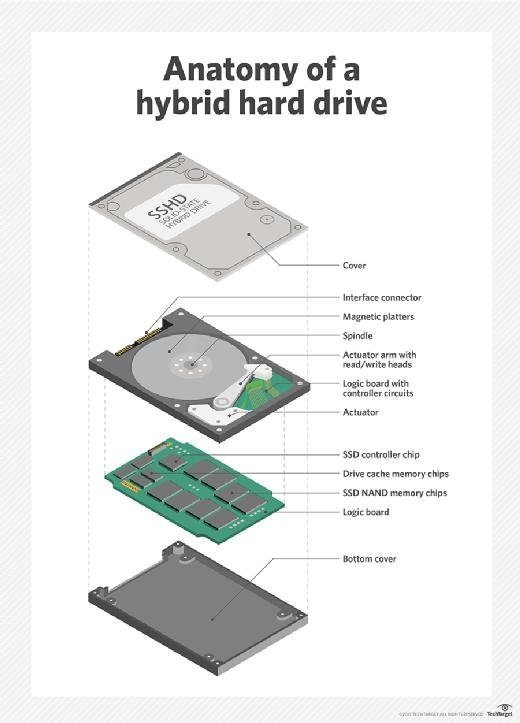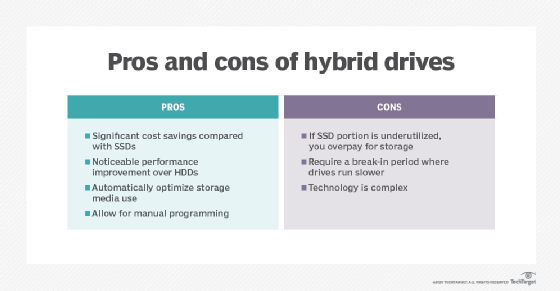SSD vs. SSHD vs. HDD: Which one is best?
Hybrid drives promise fast, cost-effective performance for primary and secondary storage. Here's what you need to know about the benefits and drawbacks compared to SSDs and HDDs.
Most enterprise storage systems are now based on all-flash, particularly in the case of primary data storage. Yet, in these budget-strapped times, it pays to look at drives that blend flash SSDs with hard disks to provide extra secondary capacity at an affordable price. Multiple vendors offer these solid-state hybrid drives, which combine a traditional high-capacity HDD with high-speed SSD technology.
What is an HDD?
HDD is an acronym standing for hard disk drive. In other words, an HDD is a traditional hard drive with mechanical heads that move across spinning platters. HDDs offer high-capacity storage at a low cost per gigabyte. However, the reliance on mechanical components limits an HDD's overall performance.
What is an SSD?
SSD stands for solid-state drive. Rather than storing data on magnetic platters like HDDs do, SSDs store data in NAND flash memory. Because SSDs don't include any moving parts, they far outperform HDDs, making them the best choice for overall performance. Better still, SSDs generally consume less power and give off less heat than HDDs, while also running silently.
There are, however, a few disadvantages associated with SSDs. SSDs generally have lower capacities than HDDs, with a higher price per gigabyte -- although higher-capacity models have become available over the last few years. Additionally, the memory cells used to store data wear out with use. Early SSDs had relatively short life spans, but newer models have failure rates that are more in line with HDDs.
What is a SSHD?
SSHD stands for solid-state hybrid drive. It's also known as a hybrid hard drive. An SSHD is a device that is designed to give you the best of both worlds by combining flash memory storage and HDD storage into a single device. SSHDs have solid-state storage built in but also use HDD technology as a way of providing additional storage space.
SSHDs work by caching frequently used files to flash storage, while retaining less commonly used files on spinning media. This means that an SSHD drive initially performs similarly to an HDD, but as the drive learns which files are used most often -- and caches those frequently used files -- it begins to deliver SSD-like performance.
But, before committing to a SSHD, it pays to understand the advantages and weaknesses of HDDs, SSDs and SSHDs.

How do HDDs, SSDs and SSHDs compare?
Generally speaking, HDDs offer the highest capacity with the lowest cost per gigabyte, while SSDs tend to have smaller capacities but far better performance at a higher cost per gigabyte. SSHDs have historically fallen somewhere in the middle.
Even though using an SSHD is still a viable option in many cases, the SSHD market seems to be shrinking. A search on Newegg for the term SSHD revealed only a few dozen options. This is likely due to the fact that SSDs have become more affordable in recent years and because SSD manufacturers have been able to improve storage capacity and drive longevity. As such, it often makes sense to simply use an SSD instead of an SSHD.
To put this difference into perspective, Newegg currently sells a 2 TB Seagate FireCuda SSHD for $238.26. This 2.5-inch disk contains 2 TB of HDD storage and 8 GB of flash storage. According to the manufacturer, the drive's flash-accelerated technology can improve load times by five times over what would be possible without flash memory.
By way of comparison, Newegg sells an all-flash Seagate FireCuda disk with 2 TB of storage for $325.69. In other words, there is an $87.43 difference between the hybrid model and a comparable all-flash model. The all-flash drive offers sequential read/write speeds of 560/540 MBps, while the hybrid model is held back by its 5,400 rpm spinning media (no read/write speeds are given).
It's worth noting that Seagate's FireCuda disks are premium disks marketed toward gamers. It's possible to get a 2 TB all-flash drive for less than the cost of a FireCuda 2 TB SSHD drive. For example, Newegg currently sells a 2 TB Samsung MLC SSD for $174.11. The sequential read/write speeds for this drive are 560/530 MBps respectively, which is nearly as fast as the FireCuda SSD.
Newegg's current price for a 2 TB, 5,400 rpm Barracuda HDD is $68.96. In other words, the all-flash FireCuda drive costs nearly five times as much for the same capacity. Even the Samsung SSD costs over twice as much as the 2 TB HDD.

Which storage type is best?
There is no clear-cut answer as to which type of storage is best. It ultimately comes down to use case.
For laptops?
Most of the time, SSD storage is going to be the preferred storage type for laptops. Laptop users tend to keep a relatively modest amount of data on their devices and often supplement the built-in storage with USB drives. SSD storage, therefore, tends to be ideal for laptop users because it delivers optimal performance without sacrificing capacity -- incidentally, there are laptop SSDs with up to 8 TB of storage.
For desktops?
In the case of a desktop computer, the best storage device often comes down to budget and how the device is being used. Many desktop users choose to place the OS on an SSD and then use a separate -- not hybrid -- HDD for data storage.
Takeaway
The advantages and disadvantages of using hybrid drives vary from organization to organization. It seems likely, however, that hybrid drives will eventually be phased out, giving way to all-flash storage.








